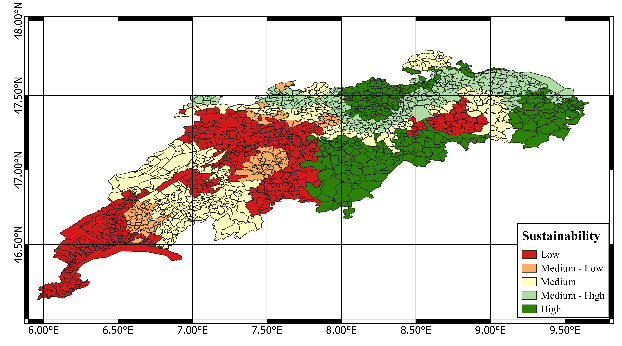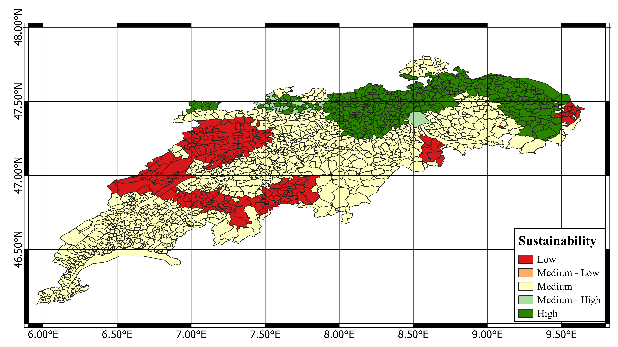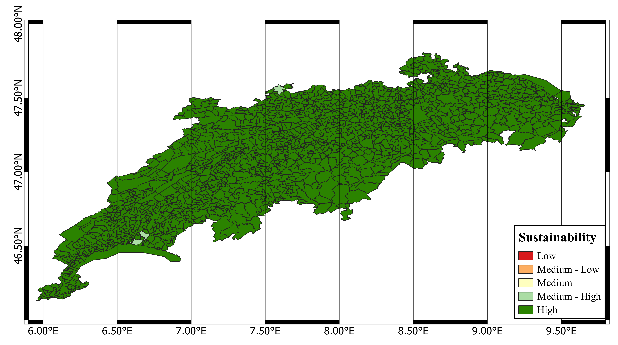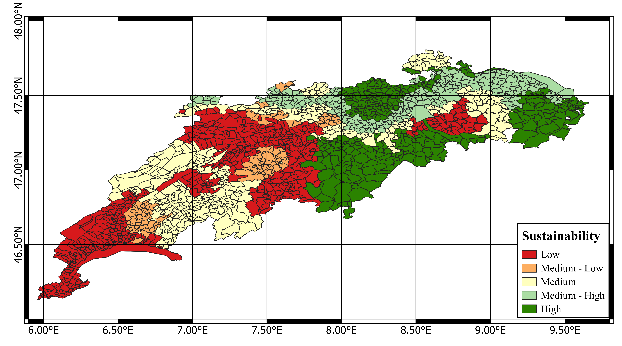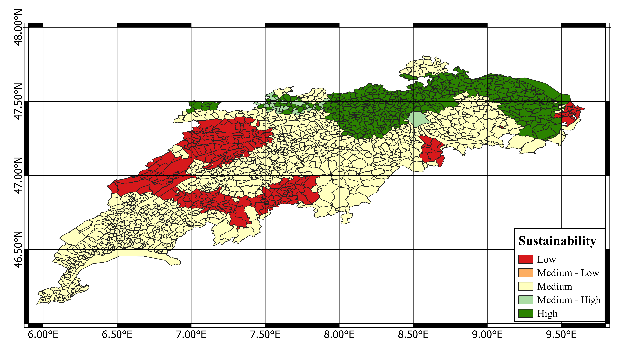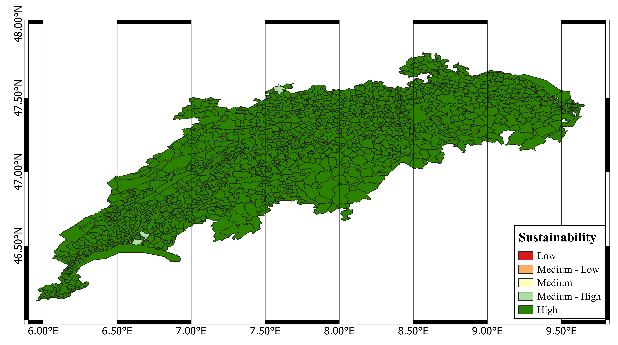Sustainability Assessment of Potential Areas for Deep Geothermal Energy Systems in Switzer-land
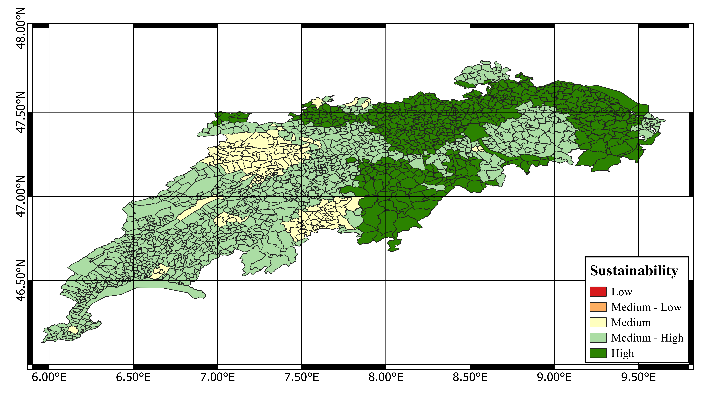
January 2021 - by Dr. Matteo Spada and Dr. Peter Burgherr
Sustainability is a key element for the future energy transition in Switzerland. In this study, scientists from the Paul Scherrer Institute (PSI) assessed the suitability of potential areas for Deep Geothermal Energy (DGE) systems in Switzerland with regard to their sustainability. Results clearly show that DGE is generally sustainable, particularly in the Northeast of Switzerland. However, the decision-makers need to consider the trade-offs between indicators (environmental, economic, social aspects) and stakeholder preferences.
The Energy Strategy 2050 requires that Switzerland replaces nuclear power by sustainable, low-carbon energy technologies. One of those technologies is deep geothermal energy (DGE), which provides a base-load option with a large potential. However, possible power plant locations are constrained by their sustainability performance, which depends on the geological conditions as well as economic, environment and social aspects.
Based on these premises, scientists from the Technology Assessment Group at the PSI developed a tool to assess the sustainability of potential areas for DGE, which combines Multi-Criteria Decision Analysis (MCDA) and Geographical Information System (GIS). MCDA allows considering a wide variety of aspects in a transparent manner, for example environmental and economic conditions. GIS accounts for the spatial variability of the problem.

Average Sustainability map for Deep Geothermal Energy in Switzerland based on a set of sample preference profiles.
A study covering 1684 municipalities in Switzerland
For their sustainability assessment, they used a so-called spatial MCDA (sMCDA) approach at the municipality level the Swiss Molasse basin. For this part of Switzerland, more DGE pilot projects are expected due to the more homogeneous – and therefore more suitable – geological conditions compared to the Alpine region. Overall, the scientists evaluated the sustainability performance for 1684 municipalities.
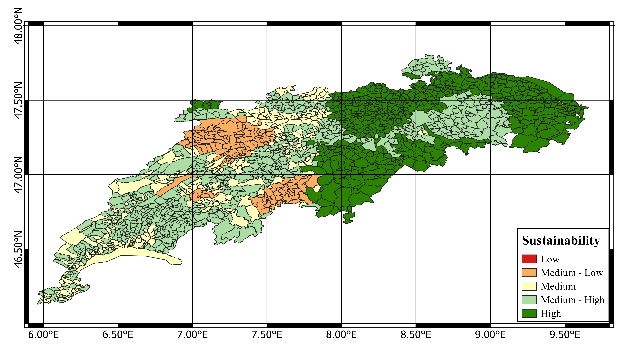
Average Sustainability map for Deep Geothermal Energy in Switzerland based on an equal weight preference profile.
Assumptions and data used for the study
Currently, no DGE plants are operational in Switzerland. Therefore, the scientists defined six hypothetical geothermal plants with two (duplet) or three (triplet) wells and three plant installed capacities for each.
To assess the DGE’s sustainability, they defined 12 indicators covering the three pillars of sustainability (environment, economy and society), which are subsequently estimated for the six hypothetical geothermal plant cases in each municipality. The five environmental indicators are Climate Change, Human Toxicity, Particulate Matter Formation, Water Depletion, and Metal Depletion. When it comes to economy, they evaluated Average Generation Cost, and Company Taxation. The five social indicators are Non-Seismic Accident Risk, Natural Seismic Risk, Induced Seismicity, Population, and Presence of National/Regional Parks.
The scientists used Life-Cycle Assessment (LCA) to calculate the environmental indicators. Climate Change expresses the kg of CO2 released in the atmosphere per kWh produced by the plant during its lifetime. Human Toxicity measures the number of years lost due to ill-health or disability in terms of kWh produced by the plant during its lifetime. Particulate Matter Formation measures the kg of PM10 released to the air per kWh produced by the plant during its lifetime. Water Depletion and Metal Depletion correspond to the kg of the specific resource depletion per kWh produced by the plant during its lifetime. All these indicators vary spatially and are sensitive to the temperature gradient in the subsoil. The Average Generation Cost indicator measures the average costs, including amortized capital, recurring and end-of-life costs, of a DGE project per kWh over the plant lifetime. It is also sensitive to the temperature gradient in the subsoil. Consequently, the scientists calculated different values of these indicators for each municipality, based on the temperature gradient of the subsoil in Switzerland.
In contrast, no spatial effects are present for Non-Seismic Accident Risk, since this indicator depends only on the number of drilled wells. The Company Taxation, which vary at the cantonal level, refers to the taxation in percentage to the industries. The Natural Seismic Risk is expressed on an ordinal scale as low, medium or high, based on the seismic zones according to the Swiss Society of Engineers (SIA) 261 standard. The scientists consider it as a proxy for social acceptance, where high values correspond to lower social acceptance and vice versa. For the Population indicator they used the number of inhabitants. The larger the population in a municipality, the higher is the risk of potentially affected inhabitants due to induced seismicity, for example.
The presence or absence of National/Regional ParksThey estimated the Induced Seismicity Indicator based on the expected total volume of fluid injected for the stimulation. The higher the volume, the higher the risk of induced seismicity.
The scientists estimated the indicator values for the six hypothetical geothermal plants in each municipality and fed them into the sMCDA. The algorithm then assigned a class of sustainability (high, medium-high, medium, medium-low, low) to each municipality considering a decision maker’s acceptance level, i.e. how demanding is a hypothetical decision-maker in accepting the proposed class of sustainability, stakeholder preferences and the uncertainty in the indicators. Since they did not carry out a survey to elicit stakeholder preferences, they defined and used representative, artificial preference profiles.
High sustainability in Northeastern Switzerland
On average, the results show that the sustainability performance of DGE in Switzerland is high in the Northeast of Switzerland. However, the artificial stakeholder profiles clearly indicate that different profiles can influence the sustainability performance of a municipality. This illustrates the sensitivity of the ranking to subjective preferences by the stakeholders. Therefore, trade-offs must be considered during an informed decision-making process, and to guide the public debate and participatory processes.
Authors

Dr. Matteo Spada holds a MSc in Physics from University of Bologna and a doctoral degree in Geophysics from ETH Zürich. He is a Senior Researcher in the Technology Assessment Group (TAG) of the Laboratory for Energy Systems Analysis (LEA) at the Paul Scherrer Institute (PSI). His research interests principally focus on (i) casualty and environmental risk related accidents in the context of the comparative evaluation energy technologies, resilience, sustainability, energy security and critical infrastructure protection; (ii) development and support of algorithms for complex decision-making processes, including Multi-Criteria Decision Analysis (MCDA) and spatial MCDA (sMCDA), for sustainability assessment purposes. Matteo is also one of the responsible for the PSI’s database ENSAD (Energy-Related Severe Accident Database) and the primary responsible for the MCDA webtools developed in the group. He is regularly publishing in peer-reviewed scientific journals, and other type of publications, as well as presenting his works are international conferences and meetings. As part of his duties, he is also engaged in the supervision of students at different levels (PhD, MSc, BSc, interns), Postdoc and Staff.

Dr. Peter Burgherr holds MSc and doctoral degrees from ETH Zurich. He leads the inter-disciplinary Technology Assessment Group (TAG) of the Laboratory for Energy Systems Analysis at the Paul Scherrer Institut (PSI). The TAG carries out integrated assessments of current and future energy technologies to support the complex decision-making processes towards a low-carbon, sustainable energy system. His personal research interests focus (1) on comparative risk assessment in the energy sector and its relevance in the broader context of sustainability, resilience, energy security and critical infrastructure protection; and (2) the use of MCDA methods to identify trade-offs and robust solutions. Furthermore, he is also the primary responsible for PSI’s database ENSAD (Energy-Related Severe Accident Database), which is the world's most authoritative database on severe accidents in the energy sector. He is regularly presenting his work at international conferences and meetings, publishing in peer-reviewed scientific journals, contributing to books, and various other publications. As part of his duties, he is also engaged in the supervision of students at different levels and lectured at different institutions.

